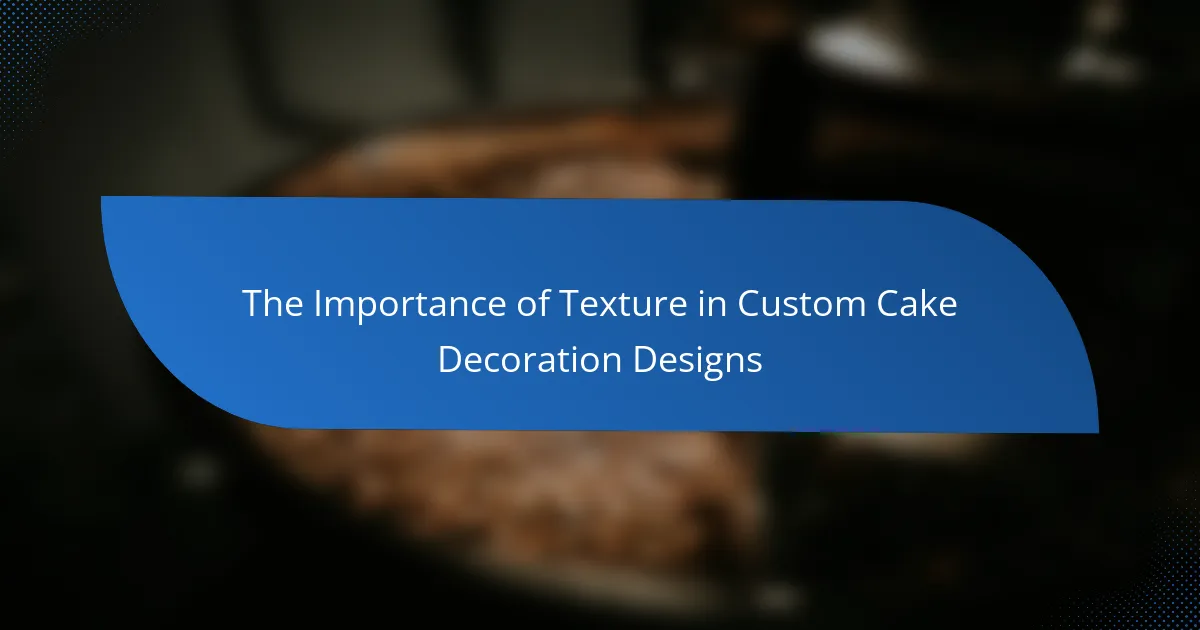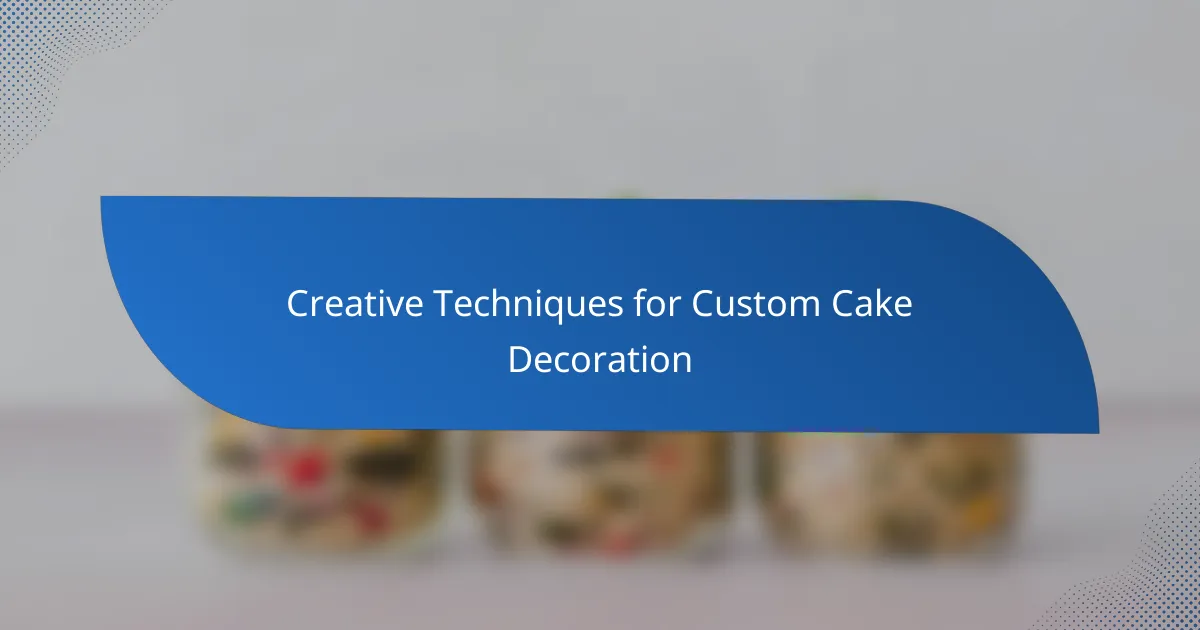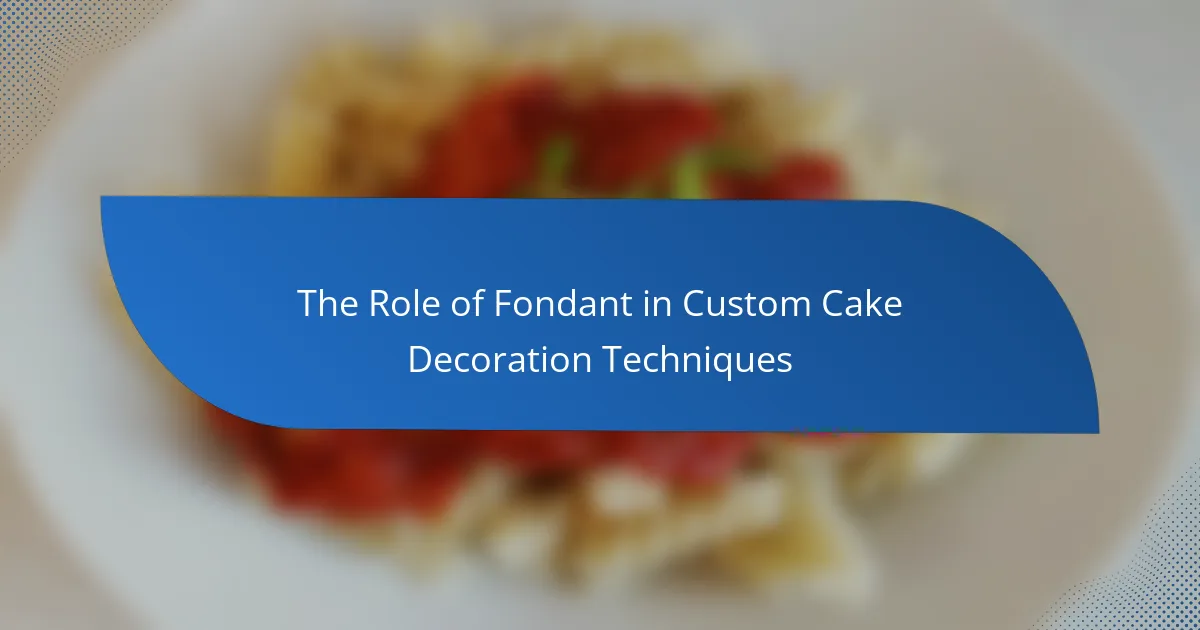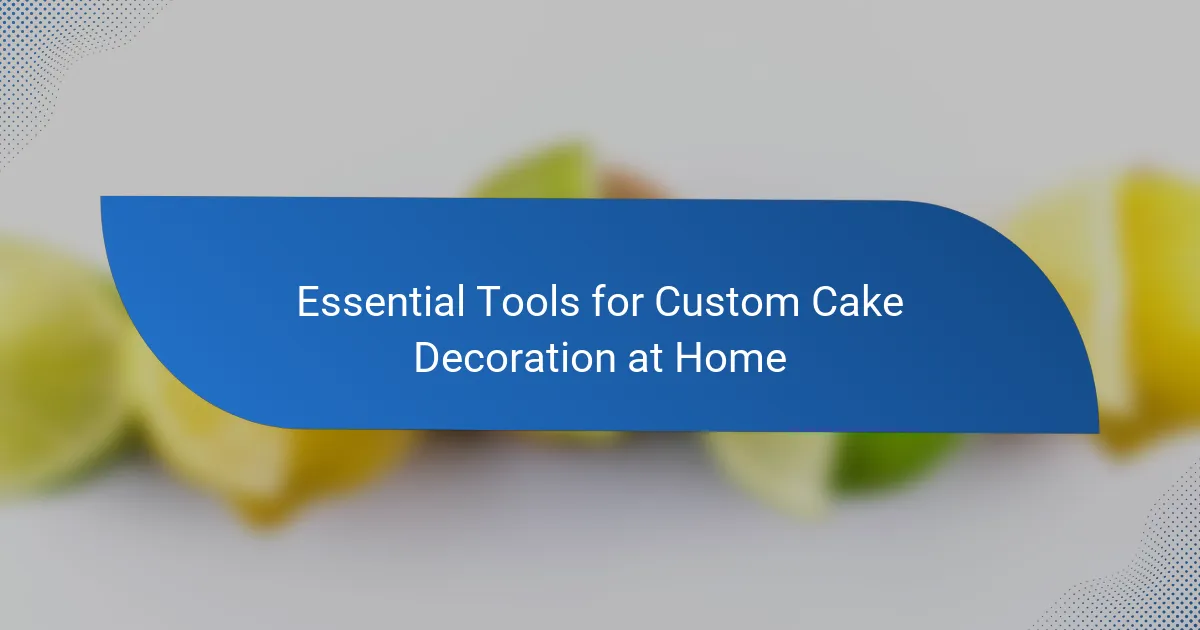Custom cake decorations for dietary restrictions are specialized designs created to meet specific dietary needs, including gluten-free and vegan options. These decorations utilize alternative ingredients such as almond or coconut flour for gluten-free cakes and plant-based substitutes for traditional animal products in vegan cakes. The article explores various techniques and materials used in creating these custom decorations while addressing challenges such as ingredient limitations and cross-contamination risks. It also highlights the importance of education for decorators to ensure customer satisfaction and the growing demand for innovative dietary-specific cake options.
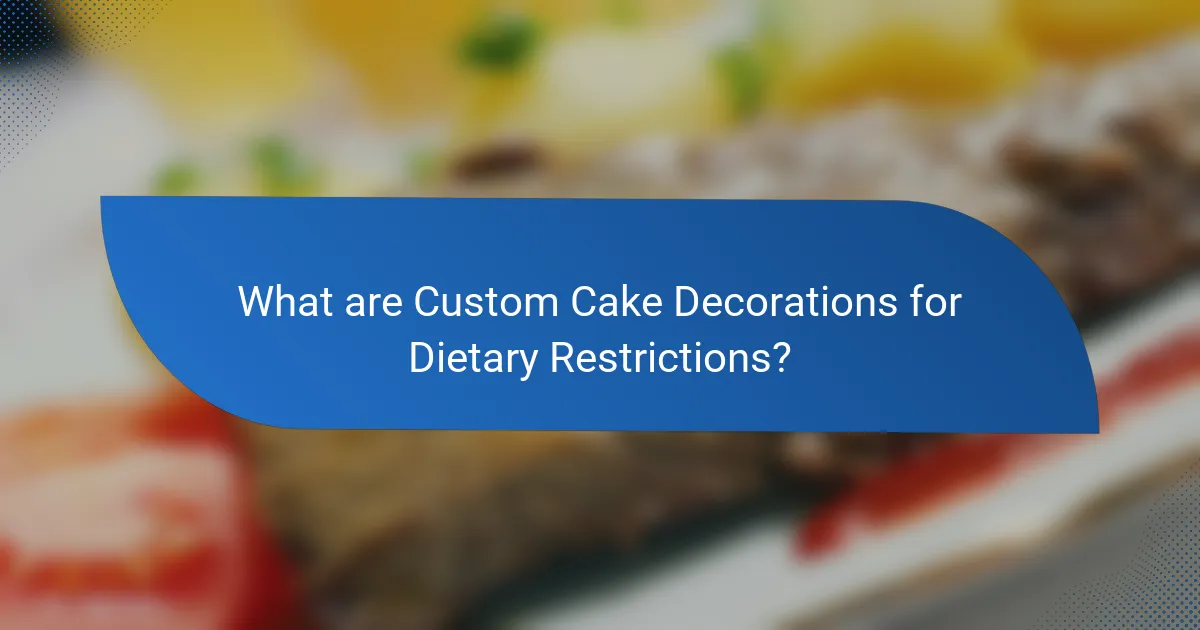
What are Custom Cake Decorations for Dietary Restrictions?
Custom cake decorations for dietary restrictions are specialized designs that cater to specific dietary needs. These decorations are often made from ingredients that are gluten-free, vegan, or allergen-free. They can include edible images, fondant shapes, and sugar decorations that comply with dietary guidelines. Many bakeries offer these options to accommodate customers with allergies or lifestyle choices. For example, gluten-free cake decorations use alternative flours like almond or coconut flour. Vegan decorations avoid all animal products, including eggs and dairy. Customization allows for personal themes while maintaining dietary compliance. This approach ensures that everyone can enjoy a celebratory cake without health concerns.
How do gluten-free and vegan options fit into custom cake decorations?
Gluten-free and vegan options are increasingly integrated into custom cake decorations to accommodate dietary restrictions. Custom cakes can be made using gluten-free flours like almond or coconut flour. These flours maintain texture and flavor while being free from gluten. Vegan options replace eggs and dairy with alternatives such as flaxseed, aquafaba, or plant-based milks. This ensures the cake is suitable for vegans without compromising taste.
Decorations can also be made vegan and gluten-free, using plant-based colors and natural ingredients. For example, fondant can be crafted from gluten-free and vegan ingredients. Edible decorations like fruits, nuts, and edible flowers are naturally gluten-free and vegan. This approach allows for visually appealing designs while adhering to dietary needs.
The demand for gluten-free and vegan cakes has risen, with a significant market growth noted in recent years. According to a report by Grand View Research, the global gluten-free market is expected to reach $41.6 billion by 2027. This trend highlights the importance of accommodating diverse dietary preferences in custom cake decorations.
What are the key differences between gluten-free and vegan cake decorations?
Gluten-free cake decorations do not contain wheat or gluten, while vegan cake decorations exclude all animal products. Gluten-free options often use alternative flours like almond or coconut flour. Vegan decorations may include ingredients such as plant-based butter and non-dairy milk. Additionally, gluten-free decorations focus on texture and structure without gluten’s binding properties. In contrast, vegan decorations emphasize flavor and moisture without eggs or dairy. Both types cater to specific dietary restrictions but differ fundamentally in their ingredient bases. Gluten-free is essential for those with celiac disease or gluten sensitivity. Vegan is crucial for those following a plant-based diet or avoiding animal products.
Why are dietary restrictions important in cake decoration?
Dietary restrictions are important in cake decoration to ensure inclusivity and safety for all consumers. Many individuals have allergies or intolerances to common ingredients like gluten or dairy. For instance, gluten affects about 1% of the population with celiac disease. Vegan options cater to those who avoid animal products for ethical or health reasons. Providing cakes that meet these dietary needs allows everyone to enjoy celebrations without health risks. Additionally, accommodating dietary restrictions can expand a bakery’s customer base. Offering gluten-free and vegan cakes can lead to increased sales and customer loyalty.
What types of occasions benefit from custom cake decorations?
Custom cake decorations benefit various occasions. Birthdays often feature personalized themes and designs. Weddings require unique decorations to match the couple’s style. Anniversaries celebrate milestones with tailored designs. Baby showers often include custom decorations that reflect the baby’s gender or theme. Graduations highlight achievements with specific motifs. Corporate events may use branded designs to enhance company identity. Holidays like Christmas or Halloween can showcase themed decorations. Each occasion can be enhanced by custom cake decorations to create memorable experiences.
How can custom cakes cater to specific dietary needs for events?
Custom cakes can cater to specific dietary needs by offering tailored ingredients and formulations. Bakers can create gluten-free cakes using alternative flours like almond or coconut flour. Vegan cakes can be made without eggs or dairy, utilizing substitutes like applesauce or almond milk. Customization allows for sugar-free options, accommodating those with diabetes. Each cake can be designed to meet allergy requirements, such as nut-free or soy-free. Many bakeries provide detailed ingredient lists to ensure transparency. This approach ensures that all guests can enjoy the cake without health concerns. Custom cakes can also be visually appealing while adhering to dietary restrictions.
What are some popular themes for gluten-free and vegan cakes?
Popular themes for gluten-free and vegan cakes include nature, celebrations, and seasonal events. Nature themes often incorporate floral designs and earthy colors. Celebration themes can feature birthdays or weddings with personalized decorations. Seasonal events include holidays like Christmas or Halloween with thematic elements. These themes cater to diverse occasions while adhering to dietary restrictions. Popularity stems from their visual appeal and inclusivity for various dietary needs.

How are Custom Cake Decorations Made for Dietary Restrictions?
Custom cake decorations for dietary restrictions are made using alternative ingredients that cater to specific needs. Gluten-free decorations utilize flours like almond or coconut instead of wheat flour. Vegan decorations replace traditional ingredients such as eggs and dairy with plant-based alternatives. Common substitutes include aquafaba for egg whites and coconut cream for whipped toppings.
These decorations often incorporate natural colors from fruits and vegetables, ensuring they are safe for various diets. Many bakers also ensure that cross-contamination is minimized by using dedicated tools and surfaces. This approach maintains the integrity of the dietary restrictions while still providing visually appealing designs.
The growing demand for dietary-specific options has led to increased innovation in cake decoration techniques and materials. As a result, many bakeries now offer a wide range of custom options suitable for gluten-free and vegan diets.
What ingredients are used in gluten-free and vegan cake decorating?
Common ingredients used in gluten-free and vegan cake decorating include plant-based frosting, gluten-free flour, and natural food colorings. Plant-based frosting is typically made from ingredients like coconut cream, cashew cream, or vegan butter. Gluten-free flour blends often consist of rice flour, almond flour, and tapioca starch. Natural food colorings can be derived from fruits, vegetables, and spices, such as beet juice or turmeric. These ingredients ensure that the cake decoration meets both gluten-free and vegan dietary requirements.
How do alternative flours affect cake texture and decoration?
Alternative flours significantly affect cake texture and decoration. They can alter the density, moisture, and crumb structure of cakes. For instance, almond flour tends to create a denser texture compared to all-purpose flour. Coconut flour absorbs more liquid, resulting in a drier cake if not balanced with additional moisture.
Rice flour, often used in gluten-free baking, can yield a grainy texture if not combined properly with other flours. These differences impact how cakes hold decorations, such as icing and fondant. Cakes made with alternative flours may require adjustments in decoration techniques due to their unique textures.
Research indicates that cakes made with alternative flours often have different rising properties, affecting their final appearance. A study from the Journal of Food Science highlights how ingredient ratios and flour types influence cake volume and texture. This underscores the importance of understanding alternative flours in achieving desired cake outcomes.
What natural substitutes can be used for traditional cake decoration ingredients?
Natural substitutes for traditional cake decoration ingredients include fruit purees, coconut cream, and nut butters. Fruit purees, such as applesauce or mashed bananas, can replace frosting or icing. Coconut cream serves as a dairy-free whipped topping alternative. Nut butters like almond or cashew butter can provide a rich, creamy texture for decoration. Additionally, edible flowers and nuts can enhance visual appeal while being gluten-free and vegan. These substitutes maintain flavor and texture while accommodating dietary restrictions.
What techniques are used for decorating gluten-free and vegan cakes?
Techniques used for decorating gluten-free and vegan cakes include using plant-based frostings, edible flowers, and fruit toppings. Plant-based frostings can be made from ingredients like coconut cream or cashew butter. Edible flowers add visual appeal and are naturally gluten-free and vegan. Fresh fruits, such as berries and citrus slices, can enhance both flavor and aesthetics. Additionally, using vegan chocolate ganache provides a rich finish. Techniques like piping with plant-based icing can create intricate designs. These methods ensure that the cakes are visually appealing while adhering to dietary restrictions.
How does the decoration process differ for gluten-free cakes?
The decoration process for gluten-free cakes often requires adjustments in technique and materials. Gluten-free cakes tend to have a different texture compared to traditional cakes. This difference can affect how frosting adheres and how decorations are applied.
For example, gluten-free cakes may be denser or crumblier. Therefore, decorators may need to use a thicker layer of frosting to create a stable surface. Additionally, certain gluten-free flours can lead to a less smooth finish. This may necessitate more careful smoothing techniques when applying fondant or other decorations.
Moreover, gluten-free cakes may require special attention to avoid cross-contamination. This is crucial when using shared tools or surfaces. Using gluten-free certified ingredients for decorations is also essential to maintain dietary safety.
Overall, while the fundamental principles of cake decoration remain the same, the specific requirements for gluten-free cakes necessitate tailored approaches to ensure both aesthetics and dietary compliance.
What are the best practices for ensuring vegan cake decorations are appealing?
Use vibrant colors and natural ingredients to enhance vegan cake decorations. Fresh fruits, edible flowers, and plant-based food colorings are visually appealing. Create textures with whipped coconut cream or nut-based frostings. Use molds and piping techniques for intricate designs. Incorporate themed elements that match the occasion for added relevance. Ensure decorations are proportionate to the cake size for balance. Consider layering decorations for depth and interest. Presentation on a beautiful cake stand can elevate the overall appeal.
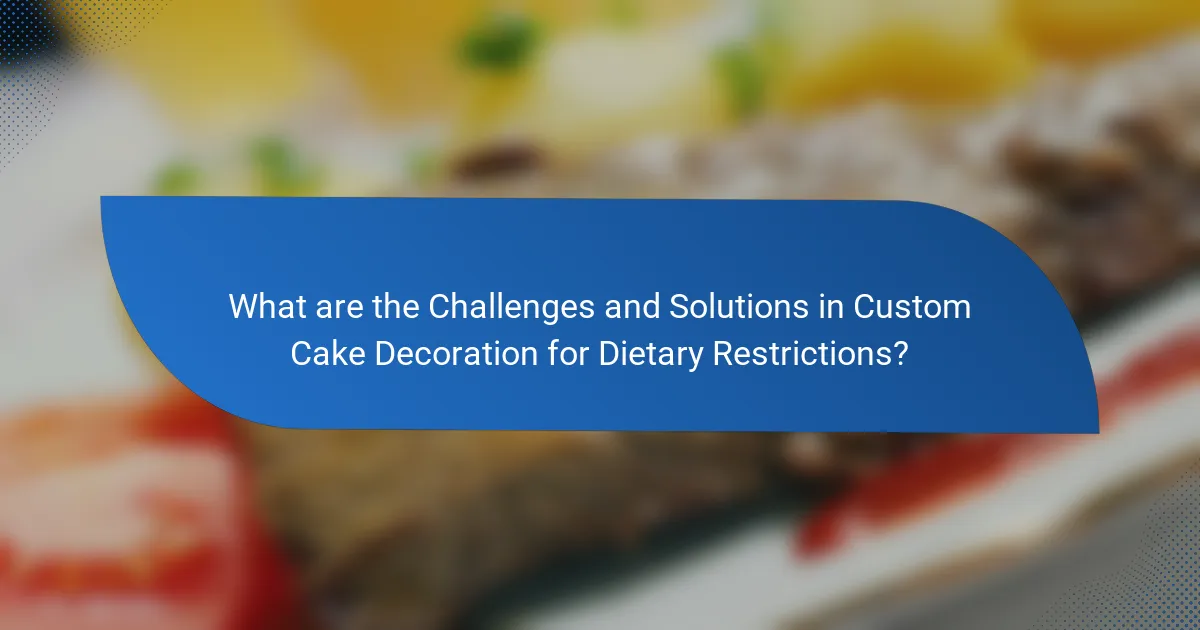
What are the Challenges and Solutions in Custom Cake Decoration for Dietary Restrictions?
The challenges in custom cake decoration for dietary restrictions include ingredient limitations and cross-contamination risks. Gluten-free and vegan options often lack traditional binding agents and flavor enhancers. This can lead to texture and taste issues in the final product. Additionally, finding suitable substitutes that meet dietary needs can be difficult.
Solutions involve using specialized recipes that cater to these restrictions. For gluten-free cakes, alternative flours like almond or coconut can be used. Vegan options can incorporate plant-based binders such as flaxseed or chia seeds.
To prevent cross-contamination, dedicated equipment and surfaces should be utilized. Education on dietary restrictions is crucial for decorators to ensure customer satisfaction. Adapting techniques and sourcing quality ingredients can significantly improve the outcome of custom cakes for dietary needs.
What common issues arise when decorating gluten-free and vegan cakes?
Common issues when decorating gluten-free and vegan cakes include structural instability, limited frosting options, and difficulty achieving desired texture. Gluten-free cakes may crumble easily due to the absence of gluten, leading to challenges in decorating. Vegan cakes often lack moisture and richness, making it hard to create a smooth finish. Additionally, many traditional decorations contain dairy or gluten, limiting choices. Finding suitable vegan and gluten-free frosting can be challenging, as many recipes may not hold up well. These factors can result in cakes that are difficult to work with and visually appealing.
How can texture and flavor be preserved in gluten-free and vegan cakes?
To preserve texture and flavor in gluten-free and vegan cakes, use a combination of alternative flours and binding agents. Almond flour, coconut flour, and oat flour can enhance moisture and density. Adding flaxseed meal or chia seeds as binders can improve structure. Incorporating ingredients like applesauce or mashed bananas adds moisture and natural sweetness. Using plant-based milk can enrich flavor without dairy. Adding spices and extracts, such as vanilla or almond extract, enhances overall taste. For texture, using nut butters can contribute creaminess. These methods are supported by various baking resources that emphasize ingredient functionality in gluten-free and vegan baking.
What troubleshooting tips can help with common decoration challenges?
Common decoration challenges can be addressed with specific troubleshooting tips. First, ensure your frosting is the right consistency. If it’s too runny, add powdered sugar gradually. If it’s too thick, incorporate a small amount of plant-based milk. Second, for fondant issues, knead it until pliable. Dust surfaces with cornstarch to prevent sticking. Third, when colors are fading, use gel food coloring for vibrant hues. Lastly, if decorations are sliding off, chill the cake before applying them for better adherence. These tips are based on common practices in cake decoration to achieve better results.
What are the best practices for successful custom cake decoration?
Successful custom cake decoration involves careful planning and execution. Start with a stable cake base to support intricate designs. Use high-quality ingredients for better flavor and texture. Choose the right tools, such as piping bags and spatulas, for precise decoration. Incorporate color theory to enhance visual appeal. Practice techniques like fondant smoothing and buttercream piping for polished finishes. Ensure all decorations are securely attached to prevent damage. For dietary restrictions, use gluten-free and vegan-friendly ingredients without compromising aesthetics. These practices lead to impressive and enjoyable custom cakes.
How can decorators ensure their designs meet dietary restrictions without compromising aesthetics?
Decorators can ensure their designs meet dietary restrictions by using alternative ingredients that align with those needs. For example, gluten-free flours like almond or coconut can replace traditional wheat flour. Vegan options can utilize plant-based substitutes for eggs and dairy, such as aquafaba or almond milk.
Incorporating natural food colorings and flavors can maintain visual appeal without compromising dietary needs. Decorators can also focus on creative presentation techniques, such as using fresh fruits or edible flowers for decoration.
Research indicates that visually appealing designs can enhance the perception of taste and quality. A study published in the journal “Appetite” found that aesthetics significantly influence food enjoyment. Thus, decorators can achieve both dietary compliance and aesthetic excellence through thoughtful ingredient selection and presentation methods.
What resources are available for learning more about custom cake decoration for dietary restrictions?
Online courses offer structured learning on custom cake decoration for dietary restrictions. Websites like Udemy and Skillshare provide classes focused on gluten-free and vegan techniques. YouTube has numerous tutorial videos demonstrating specific decoration methods. Blogs dedicated to dietary restrictions often share recipes and decorating tips. Social media platforms, particularly Instagram and Pinterest, showcase creative ideas and community support. Cookbooks focused on gluten-free and vegan baking provide in-depth techniques and inspiration. Local baking classes might also cover custom cake decoration tailored to dietary needs. These resources collectively enhance knowledge and skills in this niche area.
Custom cake decoration for dietary restrictions focuses on creating specialized designs that accommodate gluten-free and vegan needs. The article outlines the types of ingredients used, such as alternative flours and plant-based substitutes, and discusses the importance of inclusivity for those with dietary restrictions. It highlights key differences between gluten-free and vegan options, popular themes for cakes, and best practices for ensuring appealing decorations while maintaining dietary compliance. Additionally, the article addresses common challenges in the decoration process and provides resources for further learning in this niche area.
